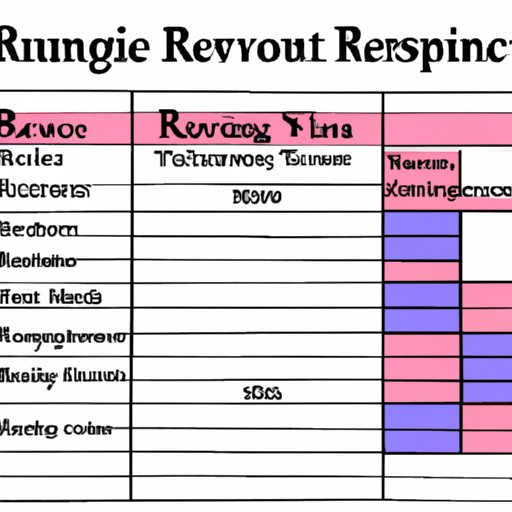Introduction
A writing rubric is an essential tool for assessing and evaluating student writing. The purpose of this article is to explain the basics of writing rubrics, examine their benefits, demonstrate how to create a writing rubric, compare different types of rubrics, identify common components of writing rubrics, analyze how writing rubrics impact student learning, and investigate the impact of writing rubrics on teacher evaluation.

Explaining the Basics of Writing Rubrics
Writing rubrics provide a framework for evaluating written work, making them an invaluable tool for both teachers and students. A rubric is essentially a set of criteria that is used to assess and evaluate student writing. It is important to note that rubrics are not just used to grade papers—they can also be used as a teaching tool to help students understand what is expected of their written work.

Examining the Benefits of Using Writing Rubrics
Using a rubric to evaluate writing has a number of advantages. First, it saves time. By having a clear set of criteria in place, teachers can quickly assess and grade student writing, allowing them to spend more time providing feedback and helping students improve their writing skills. Second, it provides consistency in grading. Rubrics ensure that all students are evaluated equally and that the same standards are applied to each piece of writing. Finally, using writing rubrics can lead to improved student performance. By being able to clearly see the criteria they are being judged on, students are more likely to produce higher quality work.

Demonstrating How to Create a Writing Rubric
Creating a writing rubric is relatively straightforward. The first step is to identify the criteria for evaluation. Ask yourself what aspects of the writing you want to evaluate and determine which criteria should be included in the rubric. Next, determine the categories for evaluation. This will depend on the type of writing being assessed. For example, if you are assessing a persuasive essay, the categories might include content, organization, grammar and punctuation, voice and style. Once the categories have been identified, it is then necessary to set the standards for each category. This involves deciding on a scoring system and outlining the expectations for each level of achievement.
Comparing Different Types of Writing Rubrics
There are two main types of writing rubrics: analytic rubrics and holistic rubrics. Analytic rubrics focus on individual elements of the writing and score each element separately. Holistic rubrics, on the other hand, provide an overall score for the piece of writing and do not take into account individual elements. Both types of rubrics have their advantages and disadvantages, so it is important to consider which one is best suited to the task at hand.
Identifying Common Components of Writing Rubrics
Most writing rubrics contain certain common components. These include content, organization, grammar and punctuation, and voice and style. Content refers to the accuracy and relevance of the information presented. Organization refers to the structure and flow of the writing. Grammar and punctuation refer to the correct use of language. And voice and style refer to the tone and style of the writing. All these components should be taken into consideration when creating a writing rubric.

Analyzing How Writing Rubrics Impact Student Learning
Using writing rubrics to evaluate student writing can have a positive effect on student learning. Firstly, it increases motivation. By having clear criteria in place, students are more likely to strive for excellence and put more effort into their work. Secondly, it improves understanding of expectations. Students are more likely to understand what is expected of them when there is a clear set of criteria that they must meet. Finally, it enhances critical thinking skills. By having to think about various aspects of their writing, such as content, organization, and grammar, students are encouraged to think more deeply about their work.
Investigating the Impact of Writing Rubrics on Teacher Evaluation
Using writing rubrics can also have a positive impact on teacher evaluation. Firstly, it increases accuracy in grading. By having a clear set of criteria, teachers can ensure that all students are evaluated fairly and consistently. Secondly, it improves communication between teacher and student. By providing students with a detailed rubric, teachers can make sure that students know exactly what is expected of them. Finally, it strengthens relationships between teachers and students. By providing students with a clear set of criteria, teachers can build trust with their students and foster a sense of collaboration.
Conclusion
In conclusion, writing rubrics are an essential tool for evaluating student writing. They provide a framework for assessing and grading written work, saving time and ensuring consistency in grading. Writing rubrics also have a positive impact on student learning, increasing motivation and enhancing critical thinking skills. Finally, they can also improve teacher evaluation, increasing accuracy in grading and strengthening relationships between teachers and students.
This article has explored the basics of writing rubrics, their benefits, components, and impact on student learning and teacher evaluation. It is hoped that this article has provided readers with a better understanding of writing rubrics and the importance of using them to evaluate writing.
(Note: Is this article not meeting your expectations? Do you have knowledge or insights to share? Unlock new opportunities and expand your reach by joining our authors team. Click Registration to join us and share your expertise with our readers.)
